Nursing Decision Making Introduction
Added on 2021-04-21
13 Pages4025 Words266 Views
Nursing Decision Making
Introduction
Nursing process and clinical decision making are crucial parts in the organization because
these impact the entire activity of the organization (Munteannd, pp. 2). The profession of
nursing faces the numerous decisions on the daily basis. It is necessary to have the
effectiveness in the decision making process to make sure the positive outcomes in the
clinical setting. The misunderstood decision making process of nurses can lead the
organization into anticipated outcomes. Moreover, immaturity in clinical thinking might
impact the decisions due to ineffective experience and knowledge (Banning 2008, pp 178).
Nursing decision making process is the skill of critical thinking. Critical thinking is the
process that shows the ability to accumulate and process data in a way to arrive the effective
conclusions. This assignment will reflect the role of critical thinking and the process of
nursing in making clinical decisions. The involvement of the decision making model is
necessary in guiding the decision making process. That is why it is vital to know about the
nurses’ decision making model and theories in aiding the learning and development of
decision making skills. Three theories will be described in this assignment to describe the
importance of decision making models and theories. One theory of them will be opted and
analyzed in the context of how nurses make decisions in their practice. Furthermore, the pros
and cons of the theory will be critically examined. Along with that the complexities,
contradictions and inconsistencies associated with the theory will be discussed in this
assignment with supporting counter argument. At last, the essay will provide the practical
Introduction
Nursing process and clinical decision making are crucial parts in the organization because
these impact the entire activity of the organization (Munteannd, pp. 2). The profession of
nursing faces the numerous decisions on the daily basis. It is necessary to have the
effectiveness in the decision making process to make sure the positive outcomes in the
clinical setting. The misunderstood decision making process of nurses can lead the
organization into anticipated outcomes. Moreover, immaturity in clinical thinking might
impact the decisions due to ineffective experience and knowledge (Banning 2008, pp 178).
Nursing decision making process is the skill of critical thinking. Critical thinking is the
process that shows the ability to accumulate and process data in a way to arrive the effective
conclusions. This assignment will reflect the role of critical thinking and the process of
nursing in making clinical decisions. The involvement of the decision making model is
necessary in guiding the decision making process. That is why it is vital to know about the
nurses’ decision making model and theories in aiding the learning and development of
decision making skills. Three theories will be described in this assignment to describe the
importance of decision making models and theories. One theory of them will be opted and
analyzed in the context of how nurses make decisions in their practice. Furthermore, the pros
and cons of the theory will be critically examined. Along with that the complexities,
contradictions and inconsistencies associated with the theory will be discussed in this
assignment with supporting counter argument. At last, the essay will provide the practical
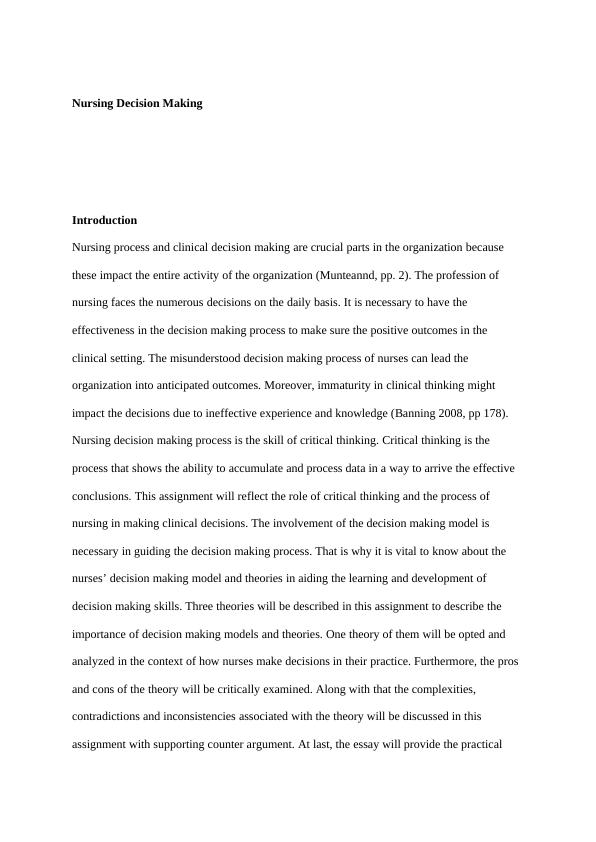
applications of intuition theory which will be considered as the most appropriate nursing
decision making theory.
Social judgement theory
Social judgment theory is considered as the framework that studies human judgment. It is a
Meta theory that defines the research on cognitive perspective which shows how someone
reacts on the situations (Asemah and Nwammuo, 2017, pp. 76). It assists to simplify the
principles of psychophysical judgmental and the social judgement. It is majorly focused on
the internal process of the personal judgment of the person in order to make the relations
between employees. It has advantages as well as disadvantages in the context of nursing
decision making which will be discussed. The advantage of social judgement theory is based
on the idea. It has been analyzed that the consequences of the persuasive message on the
specific issues is dependent on the way that the receiver analyses the situation of the message.
The nurses can take the decision by applying social judgment theory because it suggests that
formative research should be made as the campaign message (Bambini, Washburn &Perkins
2009. pp.80). The major pros of this theory is that it is practical utility, testable, predicts and
intuitive appeal. Social judgement theory also represents how people contrast their personal
positions on concerns to the position of others. It has been found that the social attitudes are
not increasing especially in the term of specific issues where the attitude is extreme (Chau,
Wong, Chow and Fung, 2014, pp.1).It means that person is not agreed with the less extreme
stands relative to his position even though the similar direction (Polit& Beck 2008). The
major agenda of this theory is creation, judgment process and critics. It assists nurses to take
decision after evaluating that why two people may perceive the single message differently.
The weakness of social judgment theory is that it is not likely to happen with clear message
and along with that this theory can impact persuasion. Another drawback of this theory is that
it ignores the other factors that can influence the persuasion.
decision making theory.
Social judgement theory
Social judgment theory is considered as the framework that studies human judgment. It is a
Meta theory that defines the research on cognitive perspective which shows how someone
reacts on the situations (Asemah and Nwammuo, 2017, pp. 76). It assists to simplify the
principles of psychophysical judgmental and the social judgement. It is majorly focused on
the internal process of the personal judgment of the person in order to make the relations
between employees. It has advantages as well as disadvantages in the context of nursing
decision making which will be discussed. The advantage of social judgement theory is based
on the idea. It has been analyzed that the consequences of the persuasive message on the
specific issues is dependent on the way that the receiver analyses the situation of the message.
The nurses can take the decision by applying social judgment theory because it suggests that
formative research should be made as the campaign message (Bambini, Washburn &Perkins
2009. pp.80). The major pros of this theory is that it is practical utility, testable, predicts and
intuitive appeal. Social judgement theory also represents how people contrast their personal
positions on concerns to the position of others. It has been found that the social attitudes are
not increasing especially in the term of specific issues where the attitude is extreme (Chau,
Wong, Chow and Fung, 2014, pp.1).It means that person is not agreed with the less extreme
stands relative to his position even though the similar direction (Polit& Beck 2008). The
major agenda of this theory is creation, judgment process and critics. It assists nurses to take
decision after evaluating that why two people may perceive the single message differently.
The weakness of social judgment theory is that it is not likely to happen with clear message
and along with that this theory can impact persuasion. Another drawback of this theory is that
it ignores the other factors that can influence the persuasion.
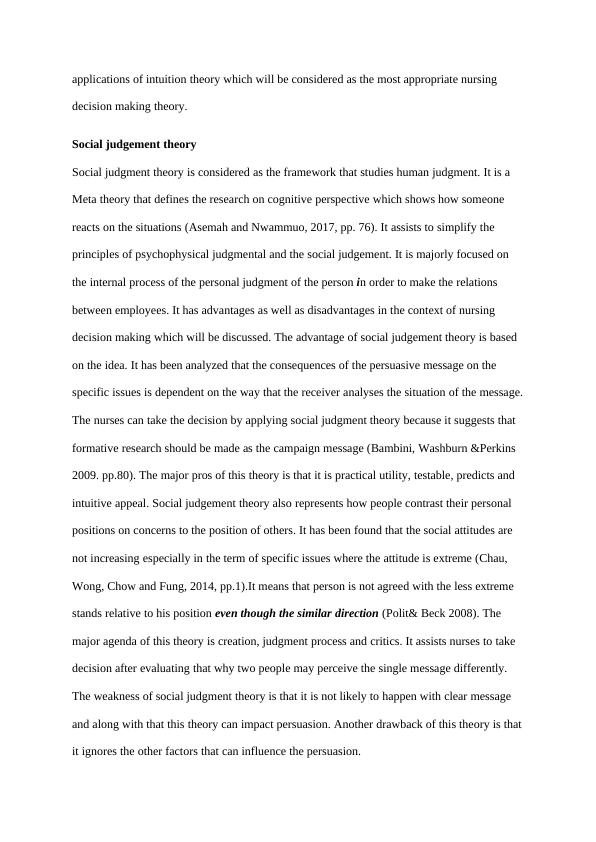
Information processing theory
Information processing theory is the approach of understanding the thinking of the human.
George A. Miller was the founder of this theory who has provided the major two ideas for
this theory that are fundamental to cognitive psychology and the information processing
framework (Moos, n.d., pp.4). Nurses of the healthcare are considered as the key decision
makers. The decision of the nurses is expected from the authority of the healthcare team and
the people that they will take best available evidence in their judgements and decisions. As
per this theory human is able to store the objective data which will be coded as the symbols
and this majorly focuses on three memory store such as sensory memory, cognitive process,
long term memory and work process memory (Moos, n.d., pp.4). Symbols refer the group
which comprise as the pattern in the brains thus memory is stored in chunks. It has been
analysed that these patterned groups of symbol are linked with external stimuli. The most
benefit point of this theory is that people identify the patterns in the time of re-occurring of
similar stimuli that pretends to fit the experience of person. Communication and the clarity is
the strength of this theory that stimulates nurses to take appropriate decision in the context of
welfare of the people (Wong & Cummings 2009, pp.524). This model is systematic that
facilitates nurses to elucidate how they reached at the decisions and what factors are
considered in the process. The cognitive processing can be seen in clear way by using this
theory. The drawback of this theory is that it consumes a lot of time of nurses to take
decisions. It only influences external events such as verbal agreements, pictures and
diagrams. It has been found that the nurses have to depend too much on the computer as an
analogy for how human thinks. The complexity of neural networks is not represented due to
sequential depiction of information processing.
Information processing theory is the approach of understanding the thinking of the human.
George A. Miller was the founder of this theory who has provided the major two ideas for
this theory that are fundamental to cognitive psychology and the information processing
framework (Moos, n.d., pp.4). Nurses of the healthcare are considered as the key decision
makers. The decision of the nurses is expected from the authority of the healthcare team and
the people that they will take best available evidence in their judgements and decisions. As
per this theory human is able to store the objective data which will be coded as the symbols
and this majorly focuses on three memory store such as sensory memory, cognitive process,
long term memory and work process memory (Moos, n.d., pp.4). Symbols refer the group
which comprise as the pattern in the brains thus memory is stored in chunks. It has been
analysed that these patterned groups of symbol are linked with external stimuli. The most
benefit point of this theory is that people identify the patterns in the time of re-occurring of
similar stimuli that pretends to fit the experience of person. Communication and the clarity is
the strength of this theory that stimulates nurses to take appropriate decision in the context of
welfare of the people (Wong & Cummings 2009, pp.524). This model is systematic that
facilitates nurses to elucidate how they reached at the decisions and what factors are
considered in the process. The cognitive processing can be seen in clear way by using this
theory. The drawback of this theory is that it consumes a lot of time of nurses to take
decisions. It only influences external events such as verbal agreements, pictures and
diagrams. It has been found that the nurses have to depend too much on the computer as an
analogy for how human thinks. The complexity of neural networks is not represented due to
sequential depiction of information processing.

Intuition theory
Intuition theory is considered as the human ability for knowing without adequate causes. It is
a process of identification of the truths without rational thinking (Senanayake, 2017, pp.5).
There are numerous definitions of intuitions. In this model, the decision maker deliberately
integrates recall knowledge that comes from education. This theory provides the information
based on the beliefs, justification is not required under this theory (Lisko&O'dell, 2010, pp.
106). The spirit of intuition has the ability to identify the cues which is helpful to increase
the experience in the management of patients in the field of nursing. Intuition theory
facilitates nurses to take decision quickly without considering any analytical model which
may confuse them. The huge benefit part of this theory is that it helps to take the quality
decision making. Intuition is able to trust on past experience to reach at the judgement
without considering the procedures of analytical (Light hall &Vazquez-Guillamet 2017, p.
156). By experiencing the same incident in the past, nurses can evaluate the current condition
and take decision as per the requirement of time. There is another merit of this theory that it
lies in the linked applications of emotions, it’s considered as the holistic approach for the
situations and the ability to recognize the amending scenarios which assist it to expand the
process of decision making by accumulating both experience and memory. Intuitive theory
can be used within the organization when goals are unclear and organization faces the major
issues. The weakness of this theory is that nurse should be experienced to apply this theory in
decision making process. It has been stated byJefford, Fahy and Sundin (2011), that nurses
are entirely reliable on intuition have information builds which are only appropriate in
specific contexts entailing that unexpected outcomes might be attained if intuitions is put for
unnecessary context. Moreover, the theory of intuition is condemned for ignoring analytical
principles.
Intuition theory is considered as the human ability for knowing without adequate causes. It is
a process of identification of the truths without rational thinking (Senanayake, 2017, pp.5).
There are numerous definitions of intuitions. In this model, the decision maker deliberately
integrates recall knowledge that comes from education. This theory provides the information
based on the beliefs, justification is not required under this theory (Lisko&O'dell, 2010, pp.
106). The spirit of intuition has the ability to identify the cues which is helpful to increase
the experience in the management of patients in the field of nursing. Intuition theory
facilitates nurses to take decision quickly without considering any analytical model which
may confuse them. The huge benefit part of this theory is that it helps to take the quality
decision making. Intuition is able to trust on past experience to reach at the judgement
without considering the procedures of analytical (Light hall &Vazquez-Guillamet 2017, p.
156). By experiencing the same incident in the past, nurses can evaluate the current condition
and take decision as per the requirement of time. There is another merit of this theory that it
lies in the linked applications of emotions, it’s considered as the holistic approach for the
situations and the ability to recognize the amending scenarios which assist it to expand the
process of decision making by accumulating both experience and memory. Intuitive theory
can be used within the organization when goals are unclear and organization faces the major
issues. The weakness of this theory is that nurse should be experienced to apply this theory in
decision making process. It has been stated byJefford, Fahy and Sundin (2011), that nurses
are entirely reliable on intuition have information builds which are only appropriate in
specific contexts entailing that unexpected outcomes might be attained if intuitions is put for
unnecessary context. Moreover, the theory of intuition is condemned for ignoring analytical
principles.
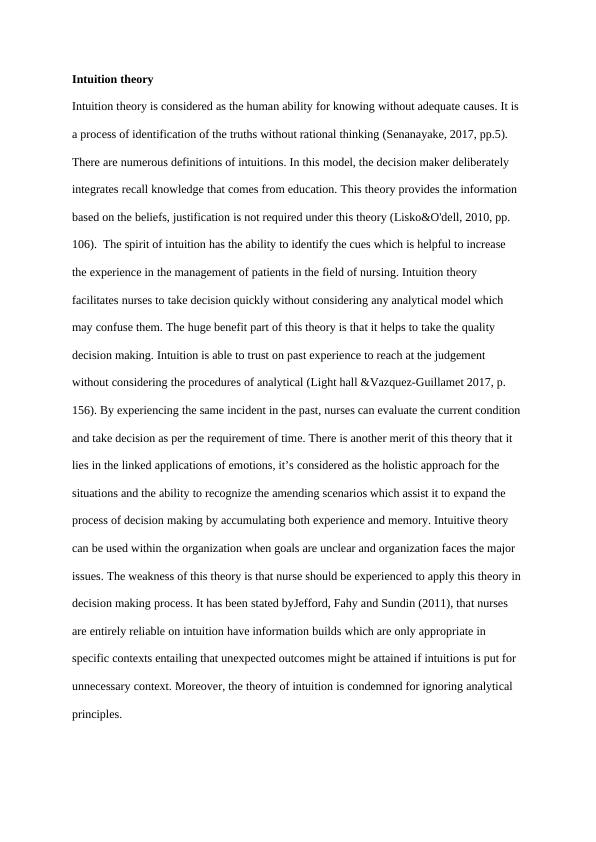
THE SCIENCE OF
NURSING DECISION
MAKING
NURSING DECISION
MAKING
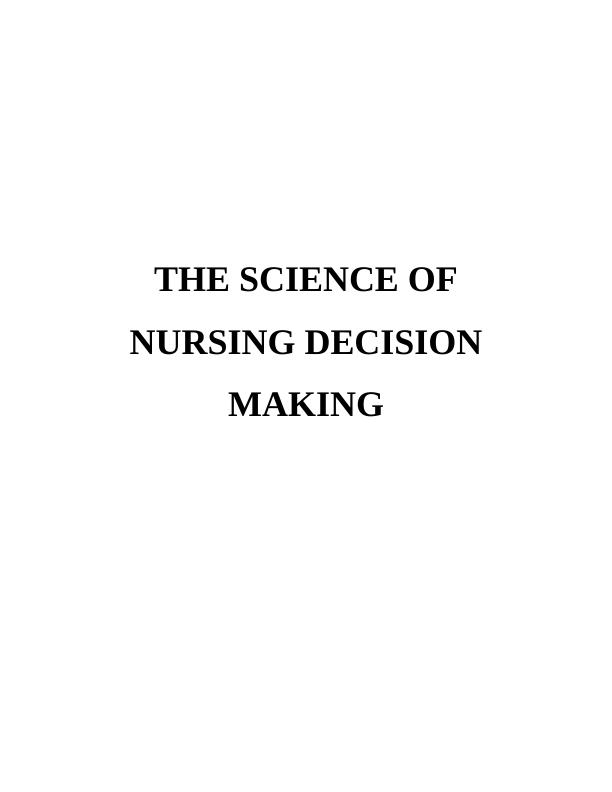
Maryann, 28 years old, chest pain
and palpitation
Presented to Emergency Department for chest
pain and palpitation. She has history of
anxiety and depression and when arrived she
was cold and clammy and had old knife
scarring on both of her hands.
Admission: T:37 C; HR: 120 bpm; RR: 28
breaths per minutes; SpO2: 96%
With blood sugar level: 6 mmol/L and blood
pressure: 130/90 mmHg and ACVPU status
as alert
DIAGNOSIS
Whenever patient feel
uneasiness in breathing and
feel pain in chest they should
be urgently be taken to
hospital. Heart-monitoring
tests should be done and if
required patient should be
taken to emergency
department for feeling chest
discomfort. Maryann was
taken to hospital when she
felt chest pain and
palpitation. After admission
in order to accurately
diagnose her condition,
various observations were
made T:37 C; HR: 120 bpm;
RR: 28 breaths per minutes;
SpO2: 96%.
PLAN OF CARE
Plan of care depends upon reason
because of which chest pain and
palpitation. As per the case study, patient
can be provided with medication to
reduce her anxiety or stress level. She
can also be provided with baclofen as it
will help in reducing her respiratory rate
and providing relief in chest pain and
palpitation. But moreover plan of care is
to reduce her anxiety level this can be
done by bringing changes within her
daily routine life, reduce her anxiety, and
loneliness. She can also be provided with
exercise of bringing her respiratory rate
to normal. hypertension medications
should be provided to her so that her
blood pression can be brought back to
normal.
Incidence: Chest pain with palpitation is a
serious issue in which patient have
noticeably irregular and strong heartbeat.
When this irregular heart best increases
pain in chest increases.
Causes: This is manly caused due to
agitation, anxiety or exertion. Maryann
has recently lost her husband so she is
suffering from depression and anxiety.
This anxiety resulted in chest pain with
palpitation.
Symptoms: chest dis-comfort, pain, fatigue,
shortness of breath.
Patho: It is mainly caused due to excessive
exertion and anxiety results in increasing
heartbeat. It basically reflects in change
in heartbeat.
1
and palpitation
Presented to Emergency Department for chest
pain and palpitation. She has history of
anxiety and depression and when arrived she
was cold and clammy and had old knife
scarring on both of her hands.
Admission: T:37 C; HR: 120 bpm; RR: 28
breaths per minutes; SpO2: 96%
With blood sugar level: 6 mmol/L and blood
pressure: 130/90 mmHg and ACVPU status
as alert
DIAGNOSIS
Whenever patient feel
uneasiness in breathing and
feel pain in chest they should
be urgently be taken to
hospital. Heart-monitoring
tests should be done and if
required patient should be
taken to emergency
department for feeling chest
discomfort. Maryann was
taken to hospital when she
felt chest pain and
palpitation. After admission
in order to accurately
diagnose her condition,
various observations were
made T:37 C; HR: 120 bpm;
RR: 28 breaths per minutes;
SpO2: 96%.
PLAN OF CARE
Plan of care depends upon reason
because of which chest pain and
palpitation. As per the case study, patient
can be provided with medication to
reduce her anxiety or stress level. She
can also be provided with baclofen as it
will help in reducing her respiratory rate
and providing relief in chest pain and
palpitation. But moreover plan of care is
to reduce her anxiety level this can be
done by bringing changes within her
daily routine life, reduce her anxiety, and
loneliness. She can also be provided with
exercise of bringing her respiratory rate
to normal. hypertension medications
should be provided to her so that her
blood pression can be brought back to
normal.
Incidence: Chest pain with palpitation is a
serious issue in which patient have
noticeably irregular and strong heartbeat.
When this irregular heart best increases
pain in chest increases.
Causes: This is manly caused due to
agitation, anxiety or exertion. Maryann
has recently lost her husband so she is
suffering from depression and anxiety.
This anxiety resulted in chest pain with
palpitation.
Symptoms: chest dis-comfort, pain, fatigue,
shortness of breath.
Patho: It is mainly caused due to excessive
exertion and anxiety results in increasing
heartbeat. It basically reflects in change
in heartbeat.
1
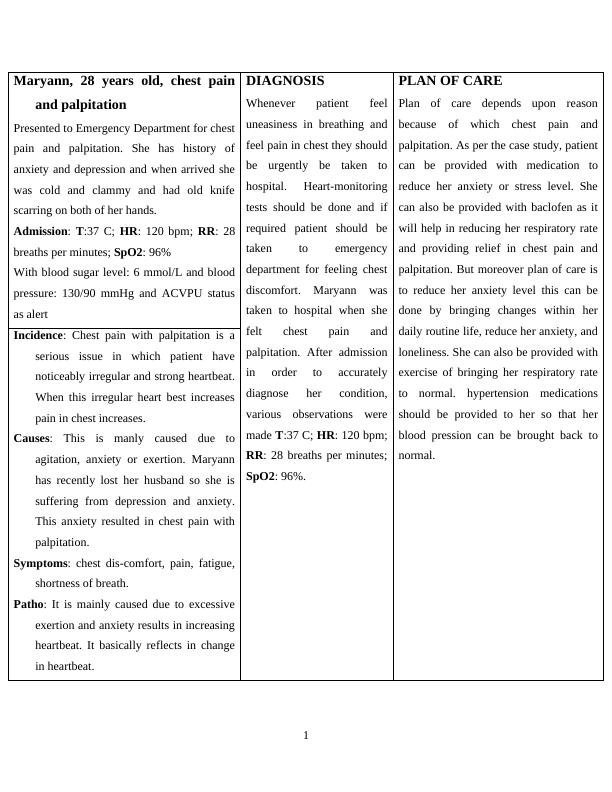
ASSESSMENT
ABCDE approach for assessment of current
condition of patient
A: Airway of patient was normal and there
was no obstruction
B: respiratory rate was high i.e., 28 breaths
per minutes but SpO2 level was normal i.e.,
96%
C: she was a bit cold but her heart rate was
normal i.e., 120 bpm
D: her ACVPU was at alert, has history of
depression and anxiety
E: full body examination was done and her
temperature was also normal 37 C
DISCHARGE PLANNING
Requirement of change in lifestyle,
meditation, reducing anxiety and
depression should be provided to patient
and her family members. Education
about psychological exercises important
to be carried should be given to patient
as well. Education about medications
that are required to be continued should
also be provided
2
ABCDE approach for assessment of current
condition of patient
A: Airway of patient was normal and there
was no obstruction
B: respiratory rate was high i.e., 28 breaths
per minutes but SpO2 level was normal i.e.,
96%
C: she was a bit cold but her heart rate was
normal i.e., 120 bpm
D: her ACVPU was at alert, has history of
depression and anxiety
E: full body examination was done and her
temperature was also normal 37 C
DISCHARGE PLANNING
Requirement of change in lifestyle,
meditation, reducing anxiety and
depression should be provided to patient
and her family members. Education
about psychological exercises important
to be carried should be given to patient
as well. Education about medications
that are required to be continued should
also be provided
2
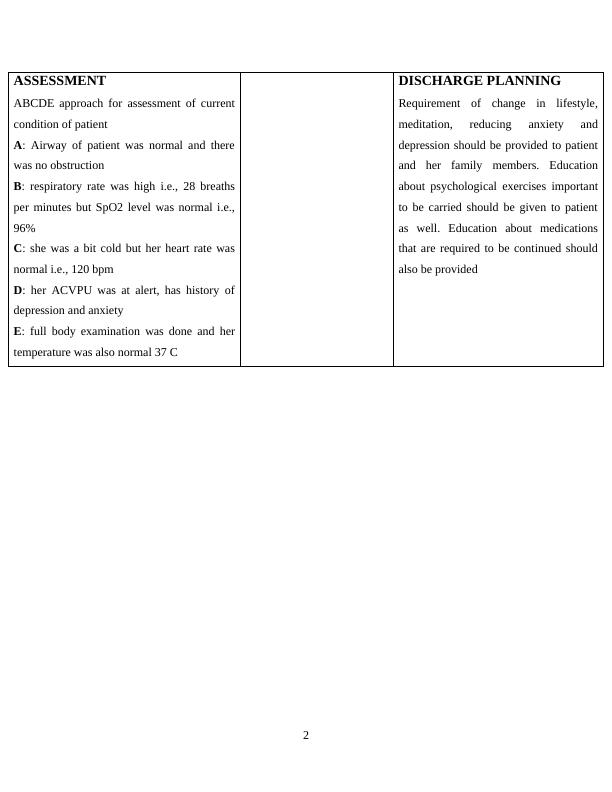
End of preview
Want to access all the pages? Upload your documents or become a member.
Related Documents
Advanced Decision Making and Practice - Essaylg...
|14
|4414
|445
Theories and Models in Nursing Practice : Reportlg...
|12
|4198
|58
Decision Making Nursing Assignmentlg...
|25
|6803
|123
Evidence of Nursinglg...
|7
|1496
|69
Reasoning Capability and Advancement of Thinking in Health and Social Carelg...
|12
|3260
|32
Decision Making Theory in Nursing Practice - PDFlg...
|12
|3942
|229